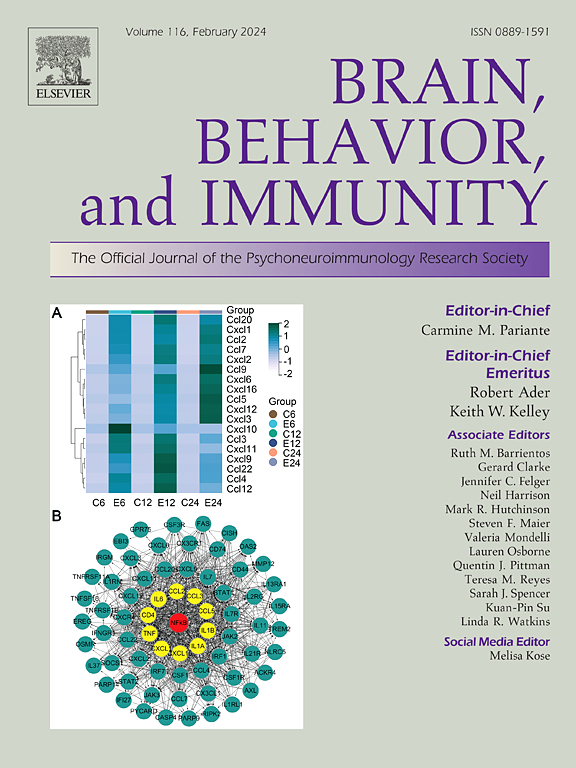Inflammatory pain resolution by mouse serum-derived small extracellular vesicles
IF 8.8
2区 医学
Q1 IMMUNOLOGY
引用次数: 0
Abstract
Current treatments for chronic pain have limited efficacy and significant side effects, warranting research on alternative strategies for pain management. One approach involves using small extracellular vesicles (sEVs), or exosomes, to transport beneficial biomolecular cargo to aid pain resolution. Exosomes are 30–150 nm sEVs that can be beneficial or harmful depending on their source and cargo composition. We report a comprehensive multi-modal analysis of different aspects of sEV characterization, miRNAs, and protein markers across sEV sources. To investigate the short- and long-term effects of mouse serum-derived sEVs in pain modulation, sEVs from naïve control or spared nerve injury (SNI) model male donor mice were injected intrathecally into naïve male recipient mice. These sEVs transiently increased basal mechanical thresholds, an effect mediated by opioid signaling as this outcome was blocked by naltrexone. Mass spectrometry of sEVs detected endogenous opioid peptide leu-enkephalin. sEVs from naïve female mice have higher levels of leu-enkephalin compared to male, matching the analgesic onset of leu-enkephalin in male recipient mice. In investigating the long-term effect of sEVs, we observed that a single prophylactic intrathecal injection of sEVs two weeks prior to induction of the pain model in recipient mice accelerated recovery from inflammatory pain after complete Freund’s adjuvant (CFA) injection. Our exploratory studies examining immune cell populations in spinal cord and dorsal root ganglion using ChipCytometry suggested alterations in immune cell populations 14 days post-CFA. Flow cytometry confirmed increases in CD206+ macrophages in the spinal cord in sEV-treated mice. Collectively, these studies demonstrate multiple mechanisms by which sEVs can attenuate pain.
小鼠血清源性小细胞外囊泡缓解炎性疼痛。
目前治疗慢性疼痛的方法疗效有限,而且副作用很大,因此有必要研究疼痛管理的替代策略。其中一种方法是利用小细胞外囊泡(sEVs)或外泌体来运输有益的生物分子货物,以帮助缓解疼痛。外泌体是一种 30-150 纳米的 sEV,根据其来源和货物成分的不同,可能有益也可能有害。我们报告了对各种 sEV 来源的 sEV 特征、miRNA 和蛋白质标记物的不同方面进行的全面多模式分析。为了研究小鼠血清来源的 sEV 对疼痛调节的短期和长期影响,我们将来自天真对照组或幸免神经损伤(SNI)模型雄性供体小鼠的 sEV 经鞘内注射到天真雄性受体小鼠体内。这些 sEVs 可短暂提高基础机械阈值,这种效应由阿片类药物信号介导,因为纳曲酮可阻断这种效应。与雄性小鼠相比,来自天真雌性小鼠的 sEVs 含有更高水平的 leu-enkephalin,并且在雄性受体中显示出更强的效应。在研究 sEVs 的长期效应时,我们观察到,在受体小鼠疼痛模型诱导前两周进行一次预防性鞘内注射 sEVs,可加快完全弗氏佐剂(CFA)注射后炎症性疼痛的恢复。我们利用芯片流式细胞术对脊髓和背根神经节中的免疫细胞群进行了探索性研究,结果表明,在注射完全弗氏佐剂(CFA)14 天后,免疫细胞群发生了变化。流式细胞术证实了经 sEV 处理的小鼠脊髓中 CD206+ 巨噬细胞的增加。总之,这些研究证明了 sEV 可减轻疼痛的多种机制。
本文章由计算机程序翻译,如有差异,请以英文原文为准。
求助全文
约1分钟内获得全文
求助全文
来源期刊
CiteScore
29.60
自引率
2.00%
发文量
290
审稿时长
28 days
期刊介绍:
Established in 1987, Brain, Behavior, and Immunity proudly serves as the official journal of the Psychoneuroimmunology Research Society (PNIRS). This pioneering journal is dedicated to publishing peer-reviewed basic, experimental, and clinical studies that explore the intricate interactions among behavioral, neural, endocrine, and immune systems in both humans and animals.
As an international and interdisciplinary platform, Brain, Behavior, and Immunity focuses on original research spanning neuroscience, immunology, integrative physiology, behavioral biology, psychiatry, psychology, and clinical medicine. The journal is inclusive of research conducted at various levels, including molecular, cellular, social, and whole organism perspectives. With a commitment to efficiency, the journal facilitates online submission and review, ensuring timely publication of experimental results. Manuscripts typically undergo peer review and are returned to authors within 30 days of submission. It's worth noting that Brain, Behavior, and Immunity, published eight times a year, does not impose submission fees or page charges, fostering an open and accessible platform for scientific discourse.

 求助内容:
求助内容: 应助结果提醒方式:
应助结果提醒方式:


